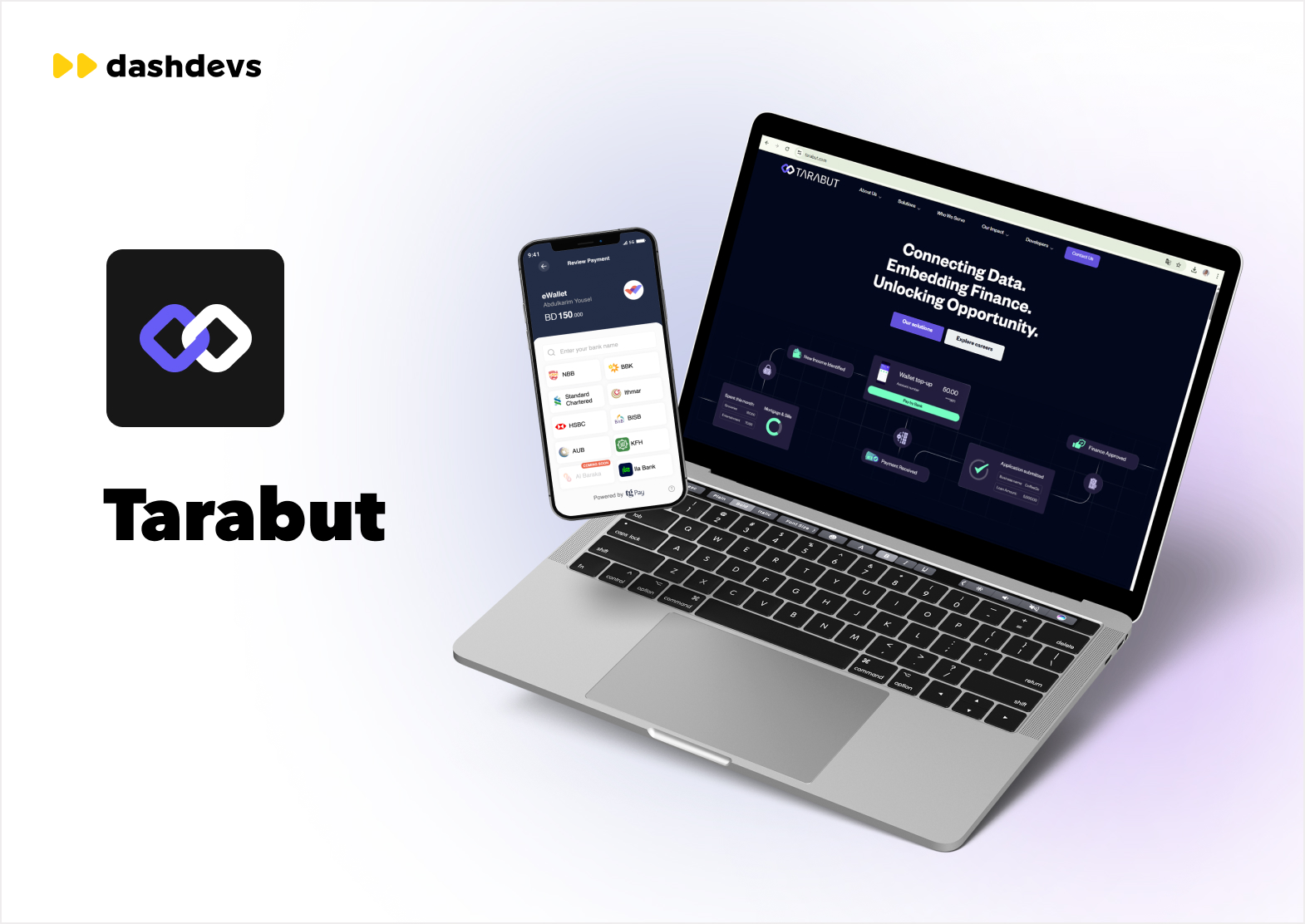NOVEMBER 22, 2025
12 min read
Open banking is driving a new era of financial connectivity, empowering businesses with real-time access to data, seamless transactions, and innovative payment solutions. With a projected 27.4% annual growth rate through 2030, API-powered financial services are becoming a competitive necessity. For C-level executives, selecting the right open banking provider means unlocking new revenue opportunities, enhancing customer engagement, and staying ahead of the digital transformation curve.
In this article, we explore the market, the leading open banking providers, and what their innovations mean for the future of financial services.
TL:DR – Key Insights
- Open banking enables secure, real-time access to financial data and payments, helping businesses reduce costs, enhance security, and deliver better customer experiences.
- The top 8 providers (Plaid, Tink, TrueLayer, Tarabut, Yapily, Volt, Salt Edge, and Banked) differ in coverage, API depth, compliance, and use cases—making careful selection essential.
- Successful open banking integration requires strong technical expertise; DashDevs ensures seamless, compliant, and scalable implementation for fintechs and enterprises.
What Is Open Banking?

Open banking allows third-party providers (TPPs) to access banking data through secure APIs, creating new opportunities for businesses and consumers alike.
Regulatory frameworks such as PSD2 in Europe, the Open Banking Initiative in the UK, and the Consumer Data Right (CDR) in Australia mandate banks to share financial data securely, paving the way for improved transparency and financial control.
Here is a graphic showing the projected growth of the global open banking market from 2020 to 2030, segmented by services such as Banking & Capital Markets, Payments, Digital Currencies, and Value-Added Services.

When Businesses Use Open Banking Platforms
These platforms act as a bridge between banks and fintech companies, enabling services such as account aggregation, payment initiation, and real-time financial insights. By leveraging these capabilities, companies can reduce transaction costs, minimize fraud risks, and provide customers with a more personalized financial experience.
- Aggregate financial data for a unified customer view
- Facilitate seamless payments with reduced transaction costs
- Enhance security through identity verification and fraud prevention
- Improve customer experience with real-time financial insights
Open banking is particularly beneficial for:
- Fintechs & BNPL providers: Streamlining operations and verifying user identities
- Banks & financial institutions: Enhancing digital banking services and compliance
- E-commerce & payment platforms: Reducing transaction fees and increasing security
- Lending & wealth management firms: Improving risk assessment and financial decision-making
It eliminates reliance on outdated data-sharing methods, accelerates payment processing, and ensures compliance with evolving financial regulations. Ultimately, open banking fosters financial inclusion, increases efficiency, and empowers consumers with greater control over their financial data.
Key Criteria for Evaluating Open Banking Platforms
Our goal was to highlight companies that offer secure, scalable, and compliant solutions tailored to the needs of banks, fintechs, and enterprises. However, even the most robust open banking platforms require seamless integration and ongoing optimization to deliver real business value. This is where partnering with an expert software development team becomes crucial.
A skilled development team ensures that businesses not only select the right platform but also implement it efficiently, customize APIs to fit unique needs, and maintain compliance with evolving regulations. Without the right expertise, companies risk integration challenges, security vulnerabilities, and performance bottlenecks.
In the section below, we evaluated each provider based on five key criteria:
- Regulatory compliance: Open banking operates in a heavily regulated environment. We prioritized providers that comply with PSD2, Open Banking UK, GDPR, and other regional regulations, ensuring seamless cross-border operations.
- API coverage and capabilities: A strong API suite is essential for success. We looked for platforms that offer payment initiation, account information access, and data aggregation, enabling businesses to build comprehensive financial solutions.
- Security and authentication: Trust is critical in financial services. We assessed providers based on their security protocols, including OAuth, Strong Customer Authentication (SCA), and advanced fraud prevention measures.
- Integration and developer support: A provider’s success depends on how easily businesses can integrate its technology. We reviewed API documentation, SDKs, sandbox environments, and developer support to ensure smooth onboarding.
- Scalability and performance: Open banking platforms must handle high transaction volumes with low latency. We measured uptime, response time, and overall system reliability to identify providers that can scale with business needs.
As both an open banking integrator and platform developer, DashDevs brings a unique vantage point: integrating APIs from providers like Tink or TrueLayer or building proprietary regional infrastructures like Tarabut in MENA.
Top 7 Open Banking Platforms
Selecting the right open banking platform is crucial for businesses aiming to enhance financial services through secure data access and seamless payment integrations. Below, we provide detailed insights into seven leading open banking apps, including their ideal use cases, key features, and pricing structures.
#1 Plaid

Plaid is a prominent open banking platform operating in the US, UK, and Europe, providing secure API access to financial data. It facilitates services such as account verification, digital payments, and identity authentication. Personal finance apps, lending platforms, and fintech companies commonly use Plaid to connect with users’ bank accounts and offer streamlined financial services.
Key features:
- APIs for account linking, income verification, and identity authentication.
- Extensive coverage across multiple regions, including the US, UK, and Europe.
- Robust security measures, including OAuth and advanced fraud detection.
Pricing & fees:
Plaid’s pricing is based on API usage, with different tiers to accommodate various business sizes and needs.
Pros:
- Wide-reaching bank connectivity across key markets.
- User-friendly integration process with comprehensive documentation.
Cons:
- Pricing may be prohibitive for startups or small enterprises.
- Some international banks may have limited support.
Our case study:
For one of our projects, an all-in-one B2B2C budgeting solution tailored for freelancers, DashDevs integrated Plaid to enable seamless financial data aggregation. The goal was to provide freelancers with real-time insights into their personal and business finances without relying on an accountant. We chose Plaid because of its wide-reaching bank connectivity and robust APIs for account linking and transaction data retrieval. This allowed their users to:
- Automatically sync their business and personal accounts.
- Track income and expenses in real-time.
- Gain insights into financial performance through AI-driven comparisons with peers.
#2 Tink

Tink, a Swedish-based open banking directory acquired by Visa in 2021, connects financial institutions to over 3,400 banks across Europe. It offers services such as account aggregation, payment initiation, and personal finance management tools.
Businesses leverage Tink to access account data, initiate payments, and verify customer identities. Notably, companies like PayPal and BNP Paribas have partnered with Tink to enhance their financial services.
Key features:
- Comprehensive API suite for account aggregation, payment initiation, and risk assessment.
- Strong authentication protocols, including OAuth and compliance with Strong Customer Authentication (SCA).
- Integration capabilities with a vast network of European banks.
Pricing & fees:
Tink offers custom pricing based on API usage and transaction volumes. Specific pricing details are available upon request from Tink’s sales team.
Pros:
- Extensive coverage across European banks.
- Robust security and compliance measures.
Cons:
- Limited presence outside of Europe.
- Custom pricing may be less accessible for smaller businesses.
#3 TrueLayer

TrueLayer is one of the UK-based open banking companies specializing in real-time payments and financial data aggregation. It enables businesses to offer instant bank payments and access consumer financial data securely. Industries such as e-commerce, trading platforms, and subscription services utilize TrueLayer to streamline payment processes and enhance user experiences.
Key features:
- Instant payment capabilities through PayDirect.
- Secure APIs for account information services (AIS) and payment initiation services (PIS).
- Compliance with PSD2, Open Banking UK, and GDPR regulations.
Pricing & fees:
TrueLayer operates on a transaction-based pricing model. They also offer free sandbox access for developers to test integrations.
Pros:
- Rapid and efficient payment processing.
- Comprehensive developer support and resources.
Cons:
- Primarily focused on the UK and EU markets.
- May not be suitable for businesses seeking global banking connections.
Our case study:
For another project, a UK-based employment verification platform, we chose TrueLayer because of its superior compliance with UK open banking regulations and its efficient API for secure financial data retrieval. The client needed a way to quickly and securely verify income and employment history for job applicants, renters, and credit applicants.
Here are the benefits they’ve got:
- Instant and GDPR-compliant employment verification.
- Secure access to income records, reducing fraud risk.
- Faster decision-making for companies needing real-time data.
TrueLayer’s robust authentication and secure data access significantly accelerated the employment verification process, helping them eliminate administrative burdens and ensure user transparency.
#4 Yapily

Yapily is a London-based open banking platform offering businesses APIs to access banking data across the UK, Europe, and beyond. Through Yapily’s single API, businesses can access bank account data, initiate payments, and verify account ownership. This streamlined solution simplifies the process and enables seamless access to essential banking functionalities for businesses of all scales.
Key features:
- API-first approach with deep financial data access.
- Capabilities for payment initiation, data aggregation, and bulk payments.
- Compliance with PSD2 and GDPR standards.
Pricing & fees:
Yapily offers custom pricing based on API usage and specific business requirements.
Pros:
- Highly scalable infrastructure suitable for large enterprises.
- Direct bank connections enhance reliability and performance.
Cons:
- Lacks a front-end interface, necessitating developer expertise for integration.
- Limited consumer-facing features compared to some competitors.
#5 Volt

Volt is an open banking payment platform that focuses on providing real-time payment solutions across various markets. It enables businesses to offer instant, secure payments directly from customers’ bank accounts, reducing reliance on traditional card networks. Industries such as retail, travel, and financial services utilize Volt to enhance payment efficiency and reduce transaction costs.
Key features:
- Instant settlements and refunds, providing immediate fund transfers.
- The Pay by Bank feature allows customers to pay directly from their banking app.
- Global reach with connections to multiple banks and financial institutions.
Pricing & fees:
Volt’s pricing structure is flexible and tailored to specific business needs. While exact fees are not publicly disclosed, they are designed to be competitive and reflect the value provided.
Pros:
- Extensive global bank connectivity.
- Focus on real-time payments enhances cash flow.
Cons:
- Pricing details are not publicly available, requiring direct consultation.
- As a relatively new player, it may have a shorter track record compared to established providers.
#6 Salt Edge

Salt Edge is a leading financial API platform specializing in open banking and PSD2 solutions. The company enables businesses to access financial data and initiate payments through a unified API, connecting to over 5,000 financial institutions across more than 50 countries.
This extensive connectivity makes Salt Edge ideal for fintechs, lenders, accounting platforms, and other financial service providers seeking to integrate comprehensive financial data and payment capabilities into their offerings. Notable clients include ING Bank, Western Union, and Pleo.
Key offerings:
- Account Information Services (AIS): Provides real-time access to end-users’ financial data from multiple banks through a single API, facilitating services like personal finance management, credit scoring, and customer verification.
- Payment Initiation Services (PIS): Enables businesses to initiate secure and cost-effective payments directly from customers’ bank accounts, offering an alternative to traditional card payments.
- Data Enrichment: Transforms raw transaction data into actionable insights through categorization and merchant identification, enhancing financial analysis and decision-making.
- Open Banking Compliance Solutions: Assists banks and electronic money institutions (EMIs) in achieving compliance with PSD2 and other open banking regulations, including API implementation, TPP verification, and strong customer authentication (SCA).
Pricing & fees:
Salt Edge offers customized pricing based on the specific needs and scale of the business. Factors influencing pricing include the number of API calls, the range of services utilized (AIS, PIS, data enrichment), and geographic coverage.
Pros:
- Extensive global bank connectivity, providing access to a wide range of financial institutions.
- Comprehensive suite of services, including data aggregation, payment initiation, and compliance solutions.
- Strong focus on security, being ISO 27001 certified, and compliant with PSD2 regulations.
Cons:
- Pricing details are not publicly disclosed, necessitating direct consultation for accurate information.
- Businesses operating outside the supported regions may face limited connectivity.
#7 Banked

Banked is an open banking app that enables real-time, account-to-account payments for consumers, businesses, and banks. It focuses on improving customer experience, payment security, and cost-effectiveness. Businesses leverage Banked to offer Pay by Bank solutions, reducing reliance on traditional card networks and associated fees.
Key features:
- Real-time payments directly between bank accounts.
- Enhanced security features reduce fraud and chargebacks.
- Improved customer experience with faster and more secure transactions.
Pricing & fees:
Specific pricing details for Banked are not publicly disclosed. Businesses interested in their services should contact Banked directly to obtain tailored pricing information.
Pros:
- Reduces transaction costs by bypassing card networks.
- Enhances payment security and reduces fraud risk.
Cons:
- Limited publicly available information on pricing and fee structures.
- May require customers to adapt to new payment methods, which could impact adoption rates.
To make it easier for you to navigate through these open banking providers, here is a comprehensive comparison table to consider:
#8 Tarabut

Tarabut is MENA’s first regulated open banking platform, pioneering financial connectivity across Bahrain, Saudi Arabia, and the United Arab Emirates. The company provides a unified open banking API infrastructure that enables banks, fintechs, and other financial institutions to securely share and access financial data while complying with regional regulations set by bodies such as the Central Bank of Bahrain and SAMA (Saudi Central Bank).
As a licensed Account Information Service Provider (AISP) and Payment Initiation Service Provider (PISP), Tarabut plays a central role in accelerating financial innovation across the GCC region. Its open banking solutions empower fintech startups, established banks, and ecosystem partners to build customer-centric products faster, enhance financial transparency, and expand digital inclusion.
DashDevs contributed to Tarabut’s platform development by helping design, build, and scale critical components of its open banking infrastructure across Bahrain, Saudi Arabia, and the UAE—strengthening its reliability, compliance alignment, and ecosystem readiness.
Key offerings:
- Account Information Services (AIS): Provides regulated access to real-time financial data across multiple banks in Bahrain, Saudi Arabia, and the UAE, enabling use cases such as personal finance management, income verification, and credit scoring.
- Payment Initiation Services (PIS): Facilitates instant, secure payments directly between customer accounts, reducing reliance on card networks and improving transaction efficiency for merchants and digital platforms.
- API Gateway & Developer Tools: Offers an API-first infrastructure with detailed documentation, sandbox environments, and developer support to streamline integration for fintech partners.
- Regulatory Compliance Solutions: Helps banks and EMIs achieve compliance with MENA open banking frameworks by providing ready-made tools for consent management, TPP verification, and customer authentication.
Pricing & fees: Tarabut offers customized pricing based on service scope, API usage, and the partner’s operational region. Interested organizations can request detailed pricing directly from Tarabut’s partnership team.
Pros:
- First fully regulated open banking platform in the MENA region.
- Strong collaboration with local regulators, ensuring full compliance with GCC open banking standards.
- End-to-end infrastructure covering AIS, PIS, and compliance capabilities.
- Proven track record through partnerships with major banks and fintechs across Bahrain, KSA, and the UAE.
How to Integrate an Open Banking Platform: The Next Step
Now that you’ve explored the leading open banking providers and identified the right fit for your business, the next step is integration. While open banking promises seamless access to financial data and payments, its actual technical implementation requires a structured approach, regulatory awareness, and deep technical expertise.
For businesses with in-house development teams, integration can still be a challenge due to compliance requirements, API complexities, and security standards. For those without dedicated developers, navigating the process alone can be overwhelming. This is where expert guidance in open banking solutions development makes a difference.
Thus, here are the key integration steps to follow:

With so many moving parts—security, compliance, and seamless API connectivity—open banking integration is a complex process. Having the right expertise on board ensures a smooth, secure, and efficient implementation, allowing your business to fully unlock the potential of open banking while staying ahead of regulatory changes and market demands.
Learn more about the benefits and risks of open banking API integration in another blog post by DashDevs.
Closing Thoughts
Choosing the right open banking provider is crucial for a seamless integration that enhances user experience, ensures security, and meets regulatory requirements. Top providers like TrueLayer, Tink, and Yapily offer robust APIs for data access and payments, but success depends on proper implementation and optimization.
At DashDevs, we specialize in integrating open banking solutions tailored to your business needs. With our deep fintech expertise, we ensure secure API connectivity, compliance, and performance optimization. Let’s connect to explore how we can help you integrate the best open banking solutions effortlessly.








